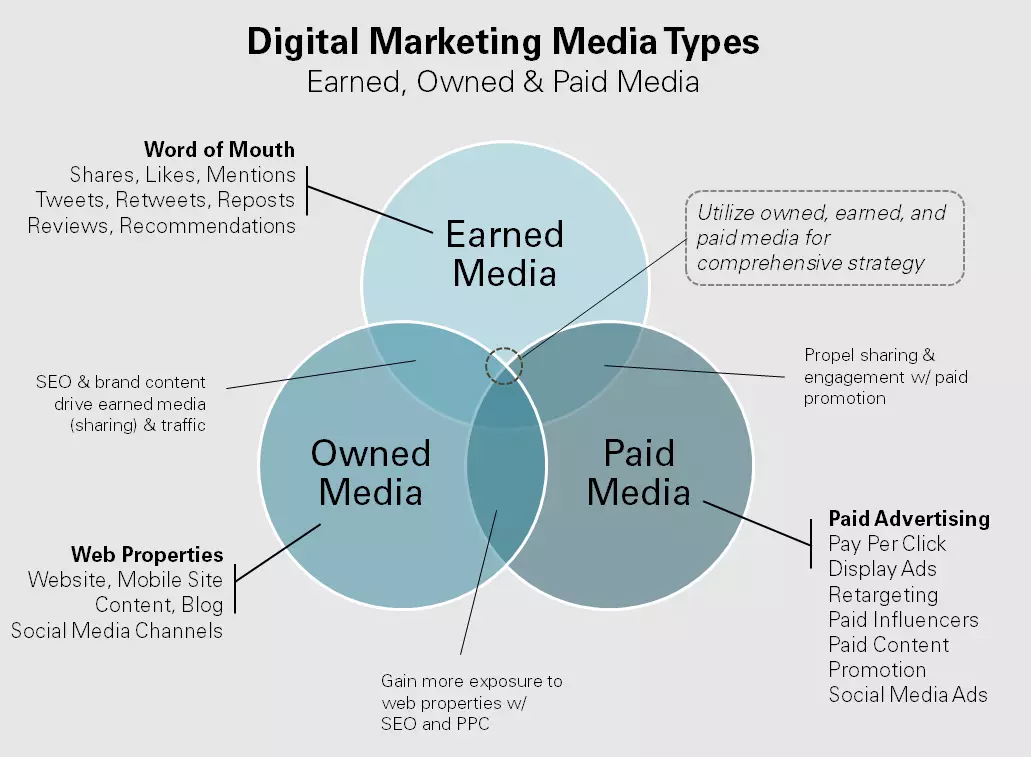Earned Media vs. Owned Media vs. Shared Media: What’s the Difference?
The internet is made of content, and some of it, just a slice, is about you. Every piece of content, every image or snippet of text, plays a role in building brand awareness, influencing your audience, and generating sales. Quality content grows your business, but you don’t have to make it all yourself. A comprehensive marketing strategy leverages different types of media to reach customers and prospects wherever they might be.
Stick around to learn about earned media, owned media, shared media, and paid media, plus how these efforts work together.

What Is Earned Media?
Earned media includes all types of publicity or brand exposure your brand receives for free. Think of earned media as what customers, the press, and your industry are saying about you. The media is earned by your actions, success, and perception in the market.
Earned media is very valuable because it is based on unsolicited reviews and recommendations; prospects trust the unbiased (or at least unpaid) opinions of third parties.
Examples of Earned Media
Earned media includes content from a wide range of marketing channels, including:
- Mentions in press releases and blogs
- Podcast mentions
- Press coverage and news articles
- Reviews on social media of review sites
- Mentions in social media content shared by others
Just because you don’t create the content doesn’t mean you can’t build on it. Earning media mention is an ongoing, proactive effort; make sure to fit these proven earned media strategies and tactics into your marketing efforts.
- Help your writers produce articles, blogs and resources that rank well in search engines and win backlinks or earn mentions on other websites and publications.
- Participate in trade shows, conferences and other events to cultivate business relationships and brand trust in person.
- Promote your content and strengthen your network on social media. Influencer marketing is another potential path to more earned media.
- Encourage employee advocacy on social media and by word-of-mouth.
What Is Owned Media?
Owned media refers to the content and platforms you own and control. It is the bread and butter of most marketing efforts and includes the primary conversion points for most brands. Think of owned media as the content you create yourself, about yourself, and own yourself.
Crucially, owned media touchpoints facilitate direct communication with your audience. You control the messaging, the branding, and the pricing or promotions.
Examples of Owned Media
If you log into it, it’s probably a type of owned media. That includes:
- Your website
- Your social media accounts
- Your email list
- Your blog
It’s yours, but that means it’s up to you to maintain, grow, and improve. Here are a few owned media strategies your team or your trusted digital marketing agency can use to maximize the value of owned media.
- Create website content that provides utility and value to the target audience. Promote and repurpose high-performing content in every way you can based on a solid SEO strategy and other channels, including social media and email marketing.
- After sharing your content on social for the first time, re-share it a few weeks later using a unique, engaging visual asset (static or video) to attract more eyes. Do your research to see when your audience is most active or when certain types of content perform best.
- Make sure your content strategy addresses all parts of the inbound marketing funnel.
What is Shared Media?
Shared media is a relatively new and admittedly ambiguous term that blends media types. It usually refers to content created by others, but often through an established partnership, paid agreement, and input from both brands. Some marketers include customer reviews as shared media, but we place reviews squarely in the earned media camp.
Examples of Shared Media
A few shared media examples include:
- Influencer marketing
- Organic user-generated content
- Co-created content or brand collaborations
A solid shared media strategy includes a carefully cultivated influencer marketing program, a strong social media presence, and excellent relationships with high-profile industry personalities willing to partner up.
What Is Paid Media?
Paid media refers to any media or assets supported with a dedicated ad budget. If it costs money to promote your content and drive brand exposure, it’s paid media. Paid media is often used to amplify owned media and win more earned media, depending on your goals.
Examples of paid media include:
- Using social media advertising platforms. Meta (Facebook, Meta, WhatsApp), TikTok, even the platform-formerly-known-as-Twitter offers paid advertising.
- Creating search ads in Google and Bing. Google Ads is the biggest ad publisher in the world and it’s a bit part of what we do. Check out our paid media services.
- Involvement in retail media networks like Amazon Ads and Walmart Connect, which are gaining market share as retailers seek shoppers in-stores and across the web.
- Strategic use of different types of display ads in various display networks.
Comparing Earned Media vs. Paid Media
The best way to compare earned and paid media is by timeline. Paid media offers an immediate impact by increasing brand awareness or driving conversions over the short term. Earned media takes longer to deliver results but has a higher return on investment in the long run.
Of course, investing in paid, earned, shared, and owned media provides the benefits of all four media types, while mitigating the disadvantages of each.
Putting the Pieces Together
Effective marketing doesn’t happen without a sound strategy. At Oneupweb, we help clients put all the pieces together, creating comprehensive multichannel marketing strategies that maximize returns. You’ll work with a dedicated account manager and a hand-picked team of professional SEOs, designers, developers, and content creators who know your business. See what nearly three decades of marketing experience can do for your organization; give us a call at (231) 922-9977 or drop us a line today.
